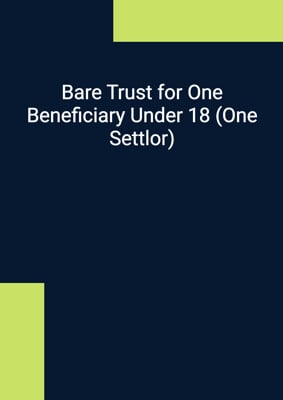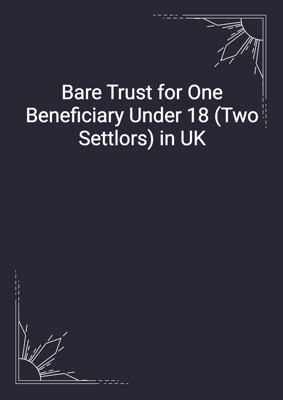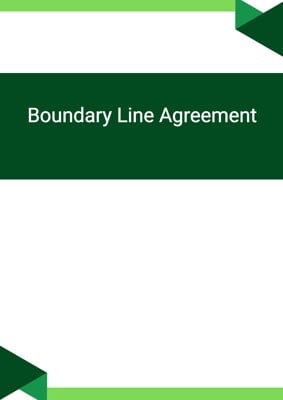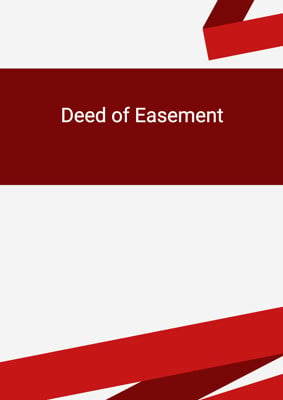How to Tailor the Document for Your Need?
01
Create Document
Fill in the details of the parties. You can click the "Fill with Member’s Information" button to complete it with information saved to your account.
02
Fill Information
Please fill in any additional information by following the step-by-step guide on the left hand side of the preview document and click the "Next" button.
03
Get Document
When you are done, click the "Get Document" button and you can download the document in Word or PDF format.
04
Review Document
The document should be signed by the authorised signatory (or directors of a company) and witnessed to complete the formality.
Document Preview
Document Description
The Certificate of Trust is a document that serves as proof of the existence and details of a trust. It is important because it provides legal evidence of the trust's creation, administration, and powers. The document begins with a statement under penalty of perjury, emphasizing the truthfulness and accuracy of the information provided.
The first section of the document identifies the trust by name and refers to the trust agreement executed by the trustee. This section establishes the trust's official name and its connection to the trustee.
The second section states the date of the trust's creation, providing a historical reference for when the trust was established. This information is crucial for determining the trust's age and legal standing.
The third section specifies the principal place of administration of the trust. This address serves as the central location where the trust's affairs are managed and where important documents and records are kept.
The fourth section includes the trust's identification number, which is a unique identifier assigned to the trust for tracking and identification purposes. This number helps differentiate the trust from others and facilitates its recognition in legal and administrative processes.
The fifth section lists the acting trustee(s) of the trust. These individuals are responsible for managing and making decisions on behalf of the trust. Their names are provided to establish their authority and involvement in the trust's affairs.
The sixth section confirms that the trust has not been revoked, modified, or amended in a way that would render the information in the document incorrect. This statement ensures that the representations made in the Certificate of Trust remain valid and reliable.
The seventh section outlines the powers of the trustee(s). It specifies whether the trustee(s) have the power to sell, convey, and exchange trust property or the power to borrow money and encumber the trust property. These powers define the extent of the trustee(s)' authority and provide clarity on their ability to act on behalf of the trust.
The eighth section varies depending on whether the trust is irrevocable or revocable. If the trust is irrevocable, the trustee is currently acting with full legal authority. If the trust is revocable, the document identifies the party(ies) with the power to revoke the trust. This section clarifies the nature of the trust and the parties involved in its potential modification or termination.
The ninth section, if applicable, includes general administrative provisions. These provisions may cover additional details or instructions related to the administration and management of the trust. They provide further guidance on how the trust should be handled and operated.
The document concludes with the name and signature of the trustee, along with the current date. This section confirms the trustee's acknowledgment and agreement with the information provided in the Certificate of Trust.
Finally, the document includes a notary acknowledgement, where a notary public verifies the authenticity of the trustee's signature. The notary public confirms that they personally witnessed the trustee's signature or verified their identity through a photo identification card. The notary's title and commission expiration date are also included for reference.
How to use this document?
1. Provide information: Fill in the state and county where the Certificate of Trust is being executed. This ensures that the document is properly localized and complies with the relevant jurisdiction.
2. Identify the trust: Enter the name of the trust as it appears in the trust agreement executed by the trustee. This establishes the official name of the trust and its connection to the trustee.
3. Specify creation date: Indicate the date when the trust was created. This information is crucial for establishing the trust's age and legal standing.
4. Provide administration address: Enter the principal place of administration of the trust. This address serves as the central location for managing the trust's affairs and maintaining important documents and records.
5. Include identification number: Enter the unique identification number assigned to the trust. This number helps differentiate the trust from others and facilitates its recognition in legal and administrative processes.
6. List acting trustee(s): Provide the name(s) of the trustee(s) currently responsible for managing the trust. This establishes their authority and involvement in the trust's affairs.
7. Confirm no revocation or modification: Ensure that the trust has not been revoked, modified, or amended in a way that would render the information in the document incorrect. This statement maintains the validity and reliability of the Certificate of Trust.
8. Specify trustee powers: Choose the appropriate power(s) that the trustee(s) possess. If applicable, select the power to sell, convey, and exchange trust property or the power to borrow money and encumber the trust property. This clarifies the extent of the trustee(s)' authority.
9. Determine trust type: Identify whether the trust is irrevocable or revocable. If it is revocable, provide the name(s) of the party(ies) with the power to revoke the trust. This section defines the nature of the trust and the parties involved in its potential modification or termination.
10. Include general administrative provisions: If necessary, add any additional provisions related to the administration and management of the trust. These provisions provide further guidance on how the trust should be handled and operated.
11. Sign and date: The trustee should sign the Certificate of Trust and include the current date. This confirms their acknowledgment and agreement with the information provided.
12. Notary acknowledgement: Have a notary public witness the trustee's signature or verify their identity through a photo identification card. This ensures the authenticity of the trustee's signature.
13. Retain a copy: Keep a copy of the fully executed Certificate of Trust for your records and future reference.
Not the right document?
Don’t worry, we have thousands of documents for you to choose from:













